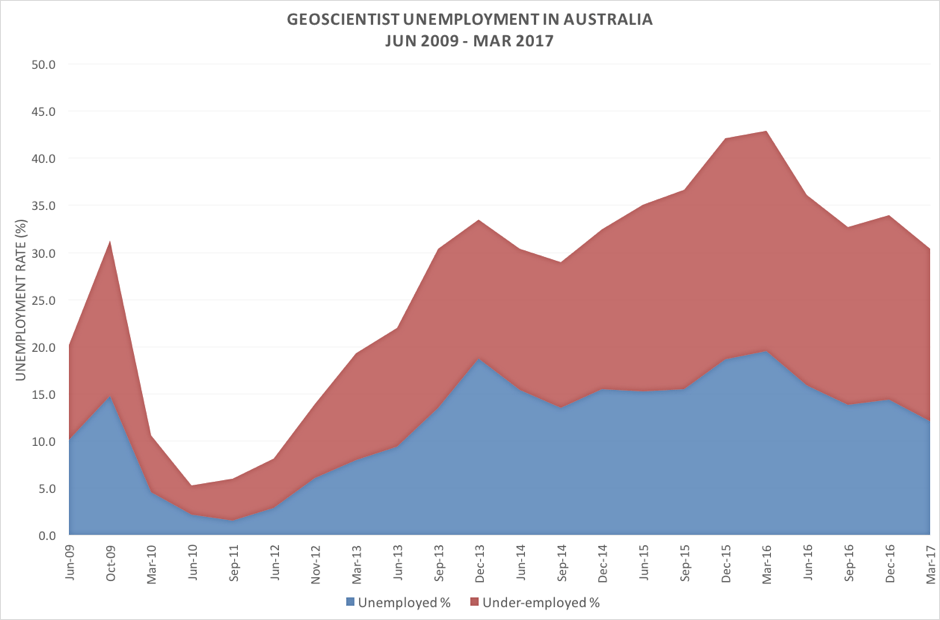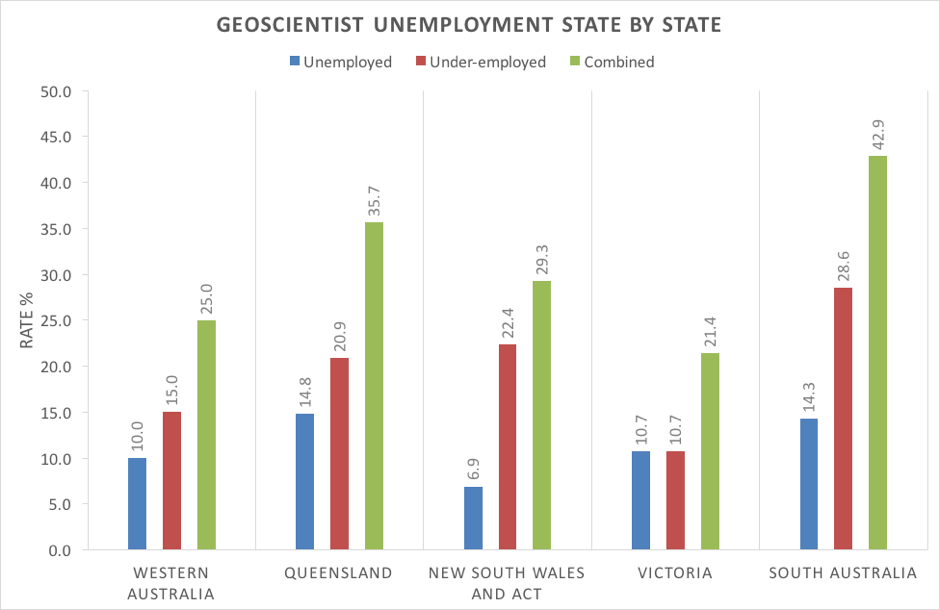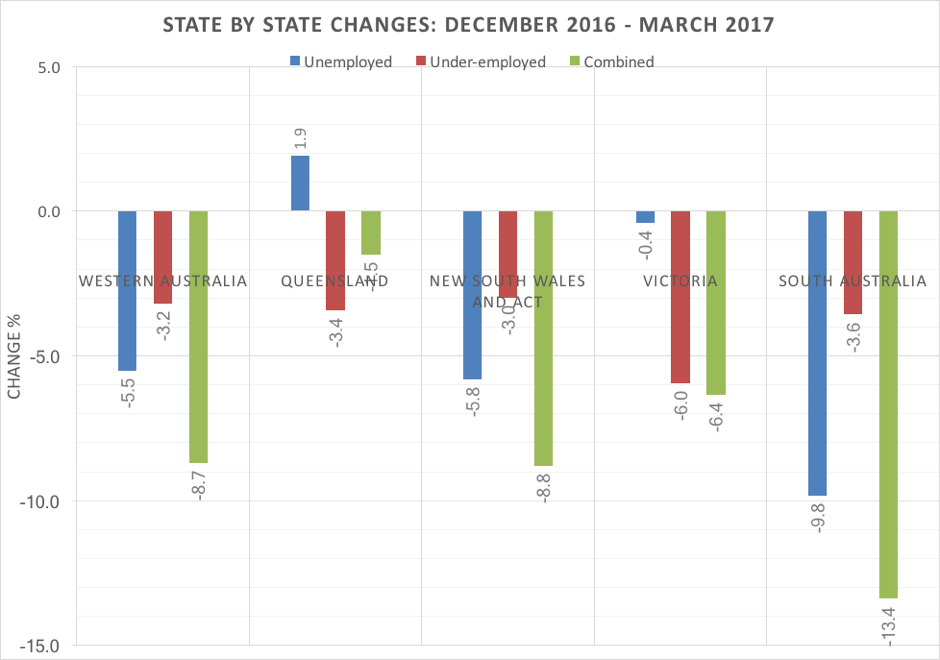Employment prospects for Australia’s embattled geoscientists improved during the first quarter of 2017 according to the latest Australian Geoscientist Employment Survey conducted by the Australian Institute of Geoscientists during April.
Unemployment amongst geoscientists during the survey period was 12.1%, down from 14.4% in the fourth quarter of 2016. Underemployment (geoscientists unable to secure their desired level of self employment) was 18.3%, down from 19.5% in the previous quarter.

Geoscientist unemployment in Australia – June 2009 to March 2017
The “real” unemployment rate (unemployed geoscientists and underemployed geoscientists able to achieve less than 25% of their desired workload was 21.7%, down from 24.5% in the final quarter of 2016.
The proportion of geoscientists seeking to leave their profession to seek work fell from 11.4% in the final quarter of 2016 to 7.9% in the latest survey.
An improvement in both unemployment and underemployment has now been evident in three of the past four surveys, supporting anecdotal evidence of a modest upturn in industry activity evident over the past year. The unemployment rate in the first quarter of 2016 was 19.5% and the corresponding underemployment rate was 23.4%.
On a state by state basis, the unemployment rate ranged from 6.9% in New South Wales and the ACT to 14.8% in Queensland. The underemployment rate was lowest in Victoria at 10.7% and highest in South Australia at 28.6%.

Geoscientist unemployment and underemployment on a state by state basis, Q1 2017

Geoscientist unemployment and underemployment on a state by state basis, Q1 2017.
Too few responses were received from geoscientists working in the Northern Territory and Tasmania to report state results.
Full-time, part-time and self-employment rates remained similar to those observed in the previous survey, at 77%, 5% and 18% respectively. Some 59% of survey respondents work, or seek work in mineral exploration, 16% in metalliferous mining and 7% in energy resource (coal, oil and gas) exploration and production.
Long-term unemployment remains a real concern. Almost 62% of unemployed and underemployed geoscientists reported that they had been out of work for 12 months or more. 16% of unemployed and underemployed geoscientists had lost their jobs during the quarter. More than 53% were not confident of regaining employment in the next 12 months.
Just over half of the survey respondents currently in employment were confident of retaining their jobs for at least the next 12 months.
The survey attracted a total of 736 responses – more than one in ten geoscientists in Australia.
“After such a prolonged period of bad news on geoscientist employment in Australia, it’s good to have something clearly positive to report” spokesperson for the Institute, Mr Andrew Waltho said. “The decline in unemployment and underemployment that we first saw some signs of in the latter part of 2016 appears to be continuing, reflecting a pick-up in exploration for minerals”.
“This good news, however, is no cause for complacency” Mr Waltho said.
“Geoscientist unemployment in Australia is still roughly three-times that of the Australian workforce in general, which is not good news for both the profession and the exploration and mining industry which accounts for the bulk of geoscientist jobs in Australia”. “They work in an industry which drives a very large piece of Australia’s economy and provides both direct and indirect employment for tens of thousands of Australians” Mr Waltho said. “Current levels of geoscientist employment are better than they were 12 months ago but are only back to mid-2013 levels” Mr Waltho said.
“More than two thirds of Australian geoscientists work in minerals exploration and mining”. The Institute asked geoscientists what they thought were the biggest barriers to greater employment in Australia, to which the overwhelming response was access to land for exploration” Mr Waltho said. “Recent research, published on AIG’s website, shows that the area of each state in Australia under exploration licence has fallen consistently over the past decade”. The most recent global survey of exploration and mining company managers undertaken by Canada’s Fraser Institute paints a varied picture of the attractiveness of policies and regulations governing mining and exploration in each Australian state”. “Western Australia and South Australia were identified as providing desirable conditions for exploration and mining”. “At the same time, one state was ranked lower than Russia as a destination for exploration and mining investment which is simply not good enough” Mr Waltho said. Australia needs to compete globally for investment in new projects”. “We have the skills and expertise to conduct world-leading exploration and mining geoscience but we need to ensure that Australia is seen to be an attractive place to invest, in which equitable access to land for responsibly conducted fieldwork is key”.
“Long term unemployment amongst Australian geoscientists is a real concern”. A majority of unemployed and underemployed geoscientists are striving to secure new employment that still isn’t there, resulting in significant numbers of highly skilled and experienced professionals seeking work outside their chosen field” Mr Waltho said.
The improvement in this survey hopefully provides some encouragement for students who will be entering the geoscience profession over the next few years”. “We are seeing some companies reinvigorate graduate recruitment and development programmes that have been a missing feature in the geoscience arena for a number of years which is also really encouraging” Mr Waltho said. “We need more, both financial and intellectual, investment in Australia’s future to maximize the value of our mineral and human resources” Mr Waltho said.